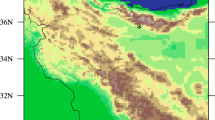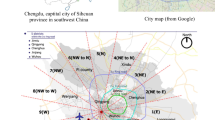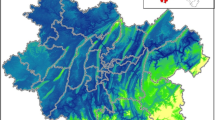Abstract
The temporal variation of ventilation coefficient was estimated and a simple model for the prediction of urban ventilation coefficient in Changsha was developed. Firstly, Pearson correlation analysis was used to investigate the relationship between meteorological parameters and mixing layer height during 2005–2009 in Changsha, China. Secondly, the multi-linear regression model between daytime and nighttime was adopted to predict the temporal ventilation coefficient. Thirdly, the validation of the model between the predicted and observed ventilation coefficient in 2010 was conducted. The results showed that ventilation coefficient significantly varied and remained high during daytime, while it stayed relatively constant and low during nighttime. In addition, the diurnal ventilation coefficient was distinctly negatively correlated with PM10 (particle with the diameter less than 10 μm) concentration in Changsha, China. The predicted ventilation coefficient agreed well with the observed values based on the multi-linear regression models during daytime and nighttime. The urban temporal ventilation coefficient could be accurately predicted by some simple meteorological parameters during daytime and nighttime. The ventilation coefficient played an important role in the PM10 concentration level.
Similar content being viewed by others
References
SUN Ye-le, ZHUANG Guo-shun, TANG Ao-han, WANG Ying, AN Zhi-sheng. Chemical characteristics of PM2.5 and PM10 in Haze-Fog episodes in Beijing [J]. Environmental Science and Technology, 2006, 40(10): 3148–3155.
AKPINAR S, HAKAN F O, AKPINAR E K. Evaluation of relationship between meteorological parameters and air pollutant concentrations during winter season in Elaz-g, Turkey [J]. Environmental Monitoring and Assessment, 2007, 146(1/2/3): 211–224.
EMEIS S, SCHAFER K, MUNKEL C. Surface-based remote sensing of the mixing-layer height-A review [J]. Meteorologische Zeitschrift, 2008, 17(5): 621–630.
SCHAFER K, EMERIS S, HOFFMANN H, JAHN C. Influence of mixing layer height upon air pollution in urban and sub-urban areas [J]. Meteorologische Zeitschrift, 2006, 15(6): 647–658.
GHIAUS C, ALLARD F, SANTAMOURIS M, GEORGAKIS C, NICO F. Urban environment influence on natural ventilation potential [J]. Building and Environment, 2006, 41(4): 395–406.
MOTESADDI Z S, KHAJEVANDI M, DAMEZ F D, ARDESTANI M. Determination of air pollution monitoring stations [J]. International Journal of Environmental Research, 2008, 2(3): 313–318.
GOYAL S K, CHALAPATI R C V. Assessment of atmospheric assimilation potential for industrial development in an urban environment: Kochi (India) [J]. Science of the Total Environment, 2007, 376(1/2/3): 27–39.
MARIA I G, NICOLAS A M. Air pollution potential: Regional study in Argentina [J]. Environmental Management, 2000, 25(4): 375–382.
RIGBY M, TIMMIS R, TOUMI R. Similarities of boundary layer ventilation and particulate matter roses [J]. Atmospheric Environment, 2006, 40(27): 5112–5124.
HOLZWORTH G C. Mixing depths, wind speed and air pollution potential for selected locations in the United States [J]. Journal of Applied Meteorology, 1967, 6(6): 1039–1044.
GOYAL P, RAMA K T. Dispersion of pollutants in convective low wind: A case study of Delhi [J]. Atmospheric Environment, 2002, 36(12): 2071–2079.
MANJU N, BALAKRISHNAN R, MANI N. Assimilative capacity and pollutant dispersion studies for the industrial zone of Manali [J]. Atmospheric Environment, 2002, 36(21): 3461–3471.
AN Xing-qing, ZHU Tong, WANG Zi-fa, LI Cong-ying, WANG Yue-si. A modeling analysis of a heavy air pollution episode occurred in Beijing [J]. Atmospheric Chemistry and Physics, 2007, 7: 3103–3114.
PADMANABHAMURTY B, MANDA, B B. Climatology of inversions, mixing depth and ventilation coefficients at Delhi [J]. Mausam, 1979, 30: 473–478.
KRISHNA TVBPSR, REDDY M K, REDDY R C, SINGH R N. Impact of an industrial complex on the ambient air quality: Case study using a dispersion model [J]. Atmospheric Environment, 2005, 39(29): 5395–5407.
SRIVASTAVA S, LAL S, SUBRAHAMANYAM D B, GUPTA S, VENKATARAMANI S, RAJESH T A. Seasonal variability in mixed layer height and its impact on trace gas distribution over a tropical urban site: Ahmedabad [J]. Atmospheric Research, 2010, 96(1): 79–87.
RIGBY M, TOUMI R. London air pollution climatology: Indirect evidence for urban boundary layer height and wind speed enhancement [J]. Atmospheric Environment, 2005, 42(20): 4932–4947.
GENC D D, YESILYURT C, TUNCEL G. Air pollution forecasting in Ankara, Turkey using air pollution index and its relation to assimilative capacity of the atmosphere [J]. Environmental Monitoring and Assessment, 2010, 166(1–4): 11–27.
GOYAL P, ANAND S, GERA B S. Assimilative capacity and pollutant dispersion studies for Gangtok city [J]. Atmospheric Environment, 2006, 40(9): 1671–1682.
RAMA K, REDDY M K, REDDY R C, SINGH R N. Assimilative capacity and dispersion of pollutants due to industrial sources in Visakhapatnam bowl area [J]. Atmospheric Environment, 2004, 38(39): 6775–6787
Author information
Authors and Affiliations
Corresponding author
Additional information
Foundation item: Project(51178466) supported by the National Natural Science Foundation of China; Project(FANEDD200545) supported by Foundation for the Author of National Excellent Doctoral Dissertation of China; Project(2011JQ006) supported by Fundamental Research Funds of the Central Universities of China
Rights and permissions
About this article
Cite this article
Lu, C., Deng, Qh., Liu, Ww. et al. Characteristics of ventilation coefficient and its impact on urban air pollution. J. Cent. South Univ. Technol. 19, 615–622 (2012). https://doi.org/10.1007/s11771-012-1047-9
Received:
Accepted:
Published:
Issue Date:
DOI: https://doi.org/10.1007/s11771-012-1047-9




